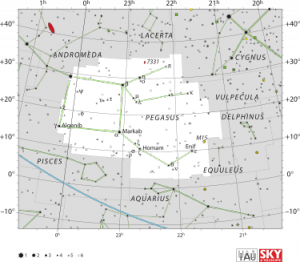Pegasus (Constellation): Difference between revisions
No edit summary |
|||
| Line 17: | Line 17: | ||
==HGS Session References== | ==HGS Session References== | ||
HGS Sessions - Clearing [[Hyperspace Phantom Matrix]] - 3/12/2015 <ref>[http://www.energeticsynthesis.com/index.php/forum/52-hgs-discussions-and-q-a-a/60650-hgs-shared-sessions-and-discussion?start=126h HGS Session]</ref> | HGS Sessions - Clearing [[Hyperspace Phantom Matrix]] - 3/12/2015 <ref>[http://www.energeticsynthesis.com/index.php/forum/52-hgs-discussions-and-q-a-a/60650-hgs-shared-sessions-and-discussion?start=126h HGS Session]</ref>HGS Sessions - Clearing [[Tara, Gaia, Cradle of Lyra]]- 3/12/2015 <ref>[http://www.energeticsynthesis.com/index.php/forum/planetary-emancipation-gridwork-peg/60919-documenting-hgs-sessions-for-peg-gridwork?start=42#101308 HGS Session]</ref> | ||
==References== | ==References== | ||
Revision as of 23:18, 20 March 2015
Pegasus is a constellation in the northern sky, named after the winged horse Pegasus in Greek mythology. It was one of the 48 constellations listed by the 2nd-century astronomer Ptolemy, and remains one of the 88 modern constellations.
With an apparent magnitude varying between 2.37 and 2.45, the brightest star in Pegasus is the orange supergiant Epsilon Pegasi, also known as Enif, which marks the horse's muzzle. Alpha (Markab), Beta (Scheat), and Gamma(Algenib), together with Alpha Andromedae (Alpheratz or Sirrah) form the large asterism known as the Square of Pegasus. Twelve star systems have been found to have exoplanets.
Covering 1121 square degrees, Pegasus ranks 7th of the 88 constellations in size. Pegasus is bordered by Andromeda to the north and east, Lacerta to the north,Cygnus to the northwest, Vulpecula, Delphinus and Equuleus to the west, Aquarius to the south and Pisces to the south and east.
Messier 15 (NGC 7078) is a globular cluster of magnitude 6.4, 34,000 light-years from Earth. It is a Shapley class IV cluster, which means that it is fairly rich and concentrated towards its center.
Pegasus is also noted for its more unusual galaxies and exotic objects. Einstein's Cross is a quasar that has been lensed by a foreground galaxy. The elliptical galaxy is 400 million light-years away with a redshift of 0.0394, but the quasar is 8 billion light-years away. The lensed quasar resembles a cross because the gravitational force of the foreground galaxy on its light creates four images of the quasar.[28] Stephan's Quintet is another unique object located in Pegasus. It is a cluster of five galaxies at a distance of 300 million light-years and a redshift of 0.0215. First discovered by Édouard Stephan, a Frenchman, in 1877, the Quintet is unique for its interacting galaxies. Two of the galaxies in the middle of the group have clearly begun to collide, sparking massive bursts of star formation and drawing off long "tails" of stars. Astronomers have predicted that all five galaxies may eventually merge into one large elliptical galaxy.[1]
History
The Babylonian constellation IKU (field) had four stars of which three were later part of the Greek constellation Hippos(Pegasus). Pegasus, in Greek mythology, was a winged horse with magical powers. One myth regarding his powers says that his hooves dug out a spring, Hippocrene, which blessed those who drank its water with the ability to write poetry. Pegasus was the one who delivered Medusa's head to Polydectes, after which he travelled to Mount Olympus in order to be the bearer of thunder and lightning for Zeus. Eventually, he became the horse to Bellerophon, who was asked to kill the Chimera and succeeded with the help of Athena and Pegasus. Despite this success, after the death of his children, Bellerophon asked Pegasus to take him to Mount Olympus. Though Pegasus agreed, he plummeted back to Earth after Zeus either threw a thunderbolt at him or made Pegasus buck him off.
In ancient Persia, Pegasus was depicted by al-Sufi as a complete horse facing east, unlike most other uranographers, who had depicted Pegasus as half of a horse, rising out of the ocean. In al-Sufi's depiction, Pegasus's head is made up of the stars of Lacerta the lizard. Its right foreleg is represented by β Peg and its left foreleg is represented by η Peg, μ Peg, and λ Peg; its hind legs are marked by 9 Peg. The back is represented by π Peg and μ Cyg, and the belly is represented by ι Peg and κ Peg. [2]
HGS Session References
HGS Sessions - Clearing Hyperspace Phantom Matrix - 3/12/2015 [3]HGS Sessions - Clearing Tara, Gaia, Cradle of Lyra- 3/12/2015 [4]
References
Found in HGS Manual on Page 108
Found in HGS Manual on Page 115



